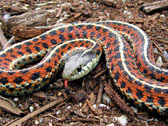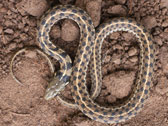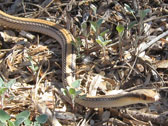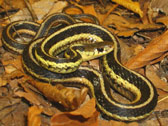Many people mistakenly refer to these snakes as Garden Snakes, because the name sounds so similar to Garter Snake. Garter Snakes are very common, with a broad range covering most of the United States, especially the populated areas. The
most easily defining feature is a stripe along the spine, for the entire length of the snake.
Are garter snakes venomous or dangerous? No. They are totally harmless. Like most snakes, they may defend themselves if threatened, and strike, but this will rarely result in any injury - maybe just a light scratch and bleeding from
their tiny teeth. If in doubt, just leave the snake alone. But no, garter snakes are not poisonous.
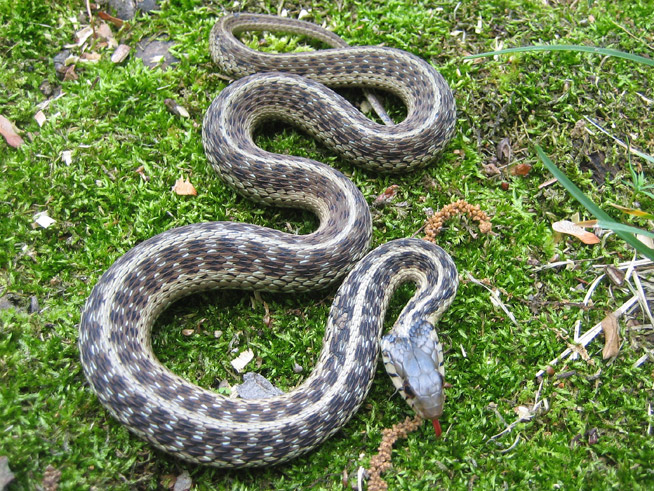
Garter Snake Appearance: Garter snakes are small bodied serpents living in North America. They are not dangerous to people, and most have a striped pattern,
often over a green or brown body, though colors can vary. This snake is surprisingly adaptable for a reptile, living in multiple regions, temperatures, and adapting to excess of water or lack thereof. These snakes are often small enough to be considered the prey of large frogs and crayfish.
Click any of the below Garter Snake photographs for a high-resolution image:
Garter Snake Habitat and Behavior: Garter snakes have adapted to live in all regions of North America, even as far north as Alaska. Some types of garter snakes have developed exceptional swimming capabilities due to their close proximity to water or moisture-dense environments. Snakes in colder climates will hibernate, commonly in groups. During this hibernation phase, they are often collected by people to be sold as pets.The garter snake is similar to other non-venomous snakes in its desire to have a den, preferably under a large rock or other support structure. For this reason, garter snakes are often found along building foundations, under steps, or in rock walls. Snakes are temperature sensitive and require means to regulate their body temperatures. Rocks provide a place to bask in the sunlight or to retreat under if the day is too warm. A small snake will often remain close to its den for quick retreat if a predator comes by. Prior to mating season and hibernation, garter snakes will travel miles to communal den sites.
Garter snakes are one of the few serpents that give birth to live young. Prior to the breeding stage, a female snake will stop eating for a period of a few weeks. After this time frame, she will release a pheromone to attract males. This potent odor will attract large numbers of males and is often the reason why homeowners suddenly think they are being overrun by garter snakes. The female snake will store the sperm until their bodies determine all the factors are appropriate for creating young. This storage of sperm can last for years. When the young begin to develop, the mother snake will find a safe den site to give birth. When the baby snakes are born—in groups of up to eighty—they are immediately on their own, receiving no nursing or care from their mother.
Pheromone communication is a key in the garter snake population. Male snakes coming out of hibernation will sometimes produce female, breeding pheromones, tricking other male snakes into an attempt to breed with them. What this really does is steal heat from the other male snake, something that is advantageous when coming out of a long, dormant state.
Garter Snake Diet: Garter snakes are carnivorous. Because of their size, they will eat anything they can overpower. The most common victims are snails, slugs, worms, crickets, grasshoppers, birds, and small mammals. Larger garter snakes can eat frogs and rodents. For a long time, garter snakes were thought to be non-venomous. This is now known to be untrue, though their venom cannot kill a human. Garter snake venom is neurotoxic, slowing down the movement of a prey animal while it is consumed.
Garter Snake Facts: Garter snakes are the most common snake in North America.
All garter snakes, regardless of base color, have a side and a back stripe.
The name “garter snake” comes from the comparison of the serpent to the garters men wore years ago to hold up their stockings.
When garter snakes hibernate, they will do so in communities with numbers reaching into the hundreds.
Bottom Line: Garter snakes are harmless to people, though they will bite if cornered and antagonized. Because of their diminutive size, these snakes are often the target of young children who want to pick them up. A garter snake will bite, and a child that has been bitten is in no immediate danger but should be taken to a medical professional for treatment if you're concerned about a bacterial infection. Even bites from small snakes can become infected. Puncture wounds often close quickly, sealing in any dirt or bacteria that were pushed under the skin. However, I've got to say that I was bitten by garter snakes a couple times as a kid, and never had any problem.
Many people want to know how to kill a Garter snake, but you don't need to. The best way to get rid of Garters is to simply leave them alone. You can also use a Garter trap to catch them - that's one of the best ways for how to remove Garter snakes. For more information, go to my Snake Removal - How to Get Rid of Snakes home page.
